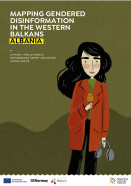MAPPING GENDERED DISINFORMATION IN THE WESTERN BALKANS – ALBANIA
July 30, 2025
In a society where women are killed with alarming frequency and where the media persistently reports such tragic incidents as “crimes of passion” rather than femicide, speaking of rape as a “moment” in which women supposedly surrender themselves to sexual pleasure is, in itself, nearly a crime. In 2023, lawyer Spartak Ngjela publicly described rape as an absence of consent and consent as a matter of morality, going so far as to state: “If she has not given her consent, at a certain point she may feel pleasure, but later she goes and files a complaint.”
This statement circulated widely across all Albanian media platforms, disseminated with the scandalous content of a lawyer who is broadly recognised by the public without raising critical questions about the weight of such a declaration, its implications for victims, or the potential harm it may inflict on future generations. Worse still, it contributed to the relativisation of rape as a crime, presenting it not as an act of violence, but as an “involuntary act that may include pleasure,” thereby neutralising its gravity.
This is merely one example among many similar media narratives that have circulated in Albanian public discourse over the past five years. While they may initially appear as conventional news items, these reports often evolve into disinformation campaigns, perpetuating gender stereotypes, normalising hate speech, and reinforcing discriminatory rhetoric. Such narratives not only undermine the principles of gender equality but also serve to consolidate deeply entrenched patriarchal structures. They reproduce and legitimise historical representations of women as inherently different and, by implication, inferior to men across social, cultural, political, and intellectual domains.
In Albania, such discursive patterns are widely prevalent and deeply embedded in public communication. Alarmingly, citizens may have become inadvertently habituated to these narratives, an outcome shaped in no small part by the pervasive use of social media. The digital ecosystem now grants virtually unlimited access to an overwhelming number of media outlets—over 900 currently active in the Albanian media landscape. These include around 60 local and national television channels, newspapers, radio stations, and online portals. However, despite this apparent diversity, Albania’s media environment remains highly concentrated in the hands of a few major owners with strong political affiliations, who control more than half of the audience and nearly 90% of the market.1 This fragmented and largely unregulated media environment not only accelerates the spread of gender-biased and discriminatory content but also fosters the normalisation of harmful ideologies, making them appear as part of everyday discourse rather than subjects of critical scrutiny.
Scholarly research on the representation, inclusion, and portrayal of women in the Albanian media has long highlighted the manipulation of public opinion by unidentified or unaccountable social actors through the dissemination of harmful and divisive narratives. While gender and media have been recurring areas of academic inquiry, in-depth studies focusing specifically on gendered disinformation remain relatively scarce. In September 2023, the organisation Faktoje published the findings of a pioneering study on gender based disinformation in the media and its consequences, particularly the intensification of hate speech and the escalation of both verbal and physical violence against women and other vulnerable communities such as LGBTIQ+. The study’s findings were neither unheard of nor unexpected; rather, they confirmed what many observers had already sensed, namely, that disinformation campaigns, especially since 2022, have become increasingly entrenched across both traditional and digital media platforms.
In the media monitoring report covering the period from January 2021 to April 2022, published by the Albanian Media Institute within the framework of the Reporting Diversity Network (RDN), hate speech and discriminatory discourse were most frequently directed at individuals and communities based on ethnicity (38.5%), gender (20.5%), and sexual orientation (12%)2. A subsequent report by the same institute, based on monitoring conducted throughout 2022, revealed that 81.8% of the recorded incidents of hate speech in Albania during that year targeted women and girls. In its most recent report, spanning January to December 20233, Albanian Media Institute once again identified gender (41%), ethnicity (38%), and sexual minorities (11%) as the three most systematically targeted groups in both traditional and digital media.
These evolving data trends point to a deeply troubling trajectory: gender has emerged as an increasingly central axis along which hate speech and discriminatory narratives are propagated. The intensification of such discourse reflects not only enduring structural inequalities but also a growing normalisation of misogyny in public and media spaces, with far-reaching consequences for gender justice.
The intensification of disinformation campaigns targeting women in Albanian media -alongside the persistent concerns raised by media monitoring experts within the framework of the RDN regarding ethical breaches, misrepresentation, image exploitation, and the re-victimisation of survivors, particularly women – has been a driving force behind the development of this regional report. These systemic patterns of gendered misrepresentation, coupled with widespread journalistic malpractice, signalled the need for a deeper, more interdisciplinary investigation into the mechanisms and impact of gendered disinformation in the region.

Download MAPPING GENDERED DISINFORMATION IN THE WESTERN BALKANS - ALBANIA
